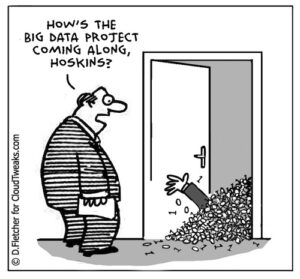 I’ve written before about HR metrics and People Analytics (that’s a form of HR analytics), but for now I want to spend one second — well, one paragraph — on the overall idea of HR data analytics.
I’ve written before about HR metrics and People Analytics (that’s a form of HR analytics), but for now I want to spend one second — well, one paragraph — on the overall idea of HR data analytics.
Now, I’m a relatively smart person but I’ve never led any HR studies or anything, so let me turn this one over to someone smarter than me.
That would be John Boudreau, who is research director t the University of Southern California’s Center for Effective Organizations. He wrote a recent blog post for the Harvard Business Review about how People Analytics needs to be more user-friendly:
A good case in point is whether HR systems actually educate business leaders about the quality of their human capital decisions. We asked this question in the Lawler-Boudreau survey and consistently found that HR leaders rate this outcome of their HR and analytics systems lowest (about 2.5 on a 5-point scale). Yet higher ratings on this item are consistently associated with a stronger HR role in strategy, greater HR functional effectiveness, and higher organizational performance.
Educating leaders about the quality of their human capital decisions emerges as one of the most potent improvement opportunities in every survey we have conducted over the past 10 years.”
Houston, we seem to have the nutshell problem.
Data analytics: Say it loud and say it proud…
Data is literally meaningless if it’s just collected. That just means you have data, which means people have more work to do trying to scrub/analyze it. Everyone is throwing themselves on the cross about their “added responsibilities.”
Data scientists are being hired at 4.5 times your salary — but it’s all trees falling in forests.
 Remember that data is only relevant IF it affects decision-making in some way, and if it’s presented to executives in a way they can understand. This is why we need “data translators.”
Remember that data is only relevant IF it affects decision-making in some way, and if it’s presented to executives in a way they can understand. This is why we need “data translators.”
Why is this seemingly rocket science?
Executives (aka, “decision-makers”) at companies have been using specific vocabulary (buzzwords and acronyms) for decades to to describe what they do. If HR terms don’t match with those terms, they will probably care less because their incentives and day-to-day schedules are tied to their terms, not whatever vocabulary that HR uses.
Let me give you an example: If you teach an executive to think of talent sourcing as a supply chain, it will have greater business impact. The executive probably knows and can conceptualize a supply chain. He will “get” it. But if you go to him with lots of HR terminology, he likely will not care or dismiss it because it’s not close enough to his “power core” of concepts.
 Now, the easiest way around this is to have decision-makers who are adaptable and care to learn more about the business. Unfortunately, I wouldn’t call that normative. When you’ve worked at a place X-time and spent Y-time of that in one silo/division, you get pretty focused up on those terms.
Now, the easiest way around this is to have decision-makers who are adaptable and care to learn more about the business. Unfortunately, I wouldn’t call that normative. When you’ve worked at a place X-time and spent Y-time of that in one silo/division, you get pretty focused up on those terms.
Back to this HR data analytics pull quote above
Here’s your main takeaway, again from John Boudreau’s HBR blog post:
Whatever HR analytics or system you use, it needs to be tied to decision-makers having more info, easier to access info, and making better decisions.”
Otherwise it’s basically being done in a vacuum. The HR data analytics are nearly worthless.
Let’s use a common HR metric example here: employee turnover.
I realize very few companies actually use exit interviews, and the ones that do are usually pretty half-assed, so often the “data” you can glean here isn’t great. But here’s what you need:
- Costs of hiring/recruiting at different salary bands;
- Costs of onboarding at different salary bands;
- Turnover by department per quarter (and annually);
- Turnover by specific manager per quarter (and annually);
- Differences in these costs — i.e. what are specific managers and departments costing the company through turnover?
- Net promoter scores
- Any exit interview insights you have gathered;
None of this data is hiding anywhere. It should all be HR data analytics that people can access relatively easily. We’re not talking brain surgery here.
So now what?
Now put together the data and here’s what it shows:
- People leave at this clip (whatever it is) …
- ... And it costs us this much money when they do …
- … so if 10 percent fewer people left, we’d save.
- And, here are some other solutions/ideas.
Now you’re talking money, and executives probably will care more. You’ll get their attention, and you’re turning HR analytics into their language. Believe me, it’s way more beneficial than trying to jam traditional HR methodology at them.
I hate to break it to you, but most really won’t care much about HR speak.
Bringing it all together on HR data analytics
Here’s what you need to do to make this all happen:
- Collect data that appears relevant (you can test over time if it actually is);
- Organize/sort the data in ways that relate to cost and the bottom line; and,
- Present what you’ve learned in ways, and with vocabulary, that are amenable to the decision-makers.
This is lots of work, but only three (3) big steps. Unfortunately I’m sure most HR/operations guys running HR will break this into 271 process steps, run everyone in circles, present a report that the executives all check their email throughout, and in the end, nothing will happen.
But, it doesn’t have to be that way!
HR data analytics CAN work. It can help you retain more employees and help you build a better workforce. What it requires is just a little big picture thinking — and some come-to-Jesus moments about your workplace data.
Authors
Ted Bauer
Originally from New York City, Ted Bauer currently lives in Fort Worth, Texas. He's a writer and editor for RecruitingDaily who focuses on leadership, management, HR, recruiting, marketing, and the future of work. His popular blog, The Context of Things, has a simple premise -- how to improve work. Ted has a Bachelors in Psychology from Georgetown and a Masters in Organizational Development from the University of Minnesota. In addition to various blogging and ghost-writing gigs, he's also worked for brands such as McKesson, PBS, ESPN, and more. You can follow Ted on Twitter @tedbauer2003, connect with him on LinkedIn, or reach him on email at [email protected]
Recruit Smarter
Weekly news and industry insights delivered straight to your inbox.





